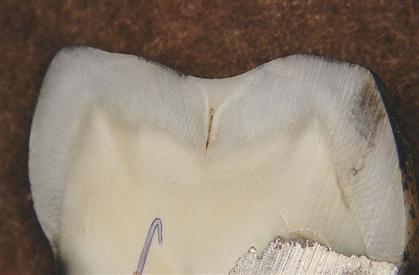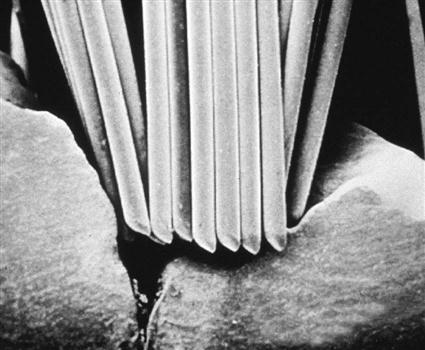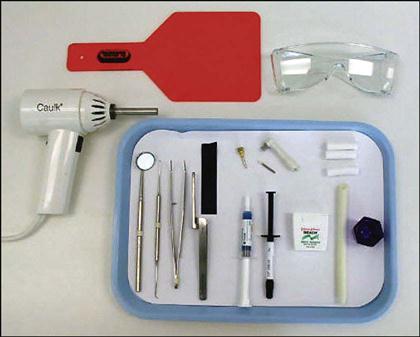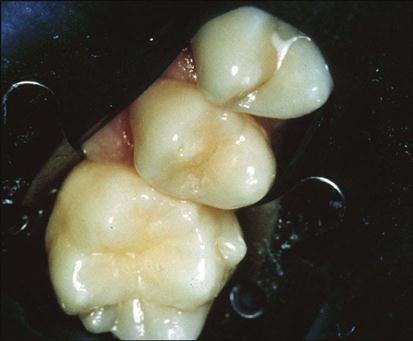Dental Sealants
Learning Outcomes
On completion of this chapter, the student will be able to achieve the following objectives:
• Pronounce, define, and spell the Key Terms.
• Describe the purpose of dental sealants.
• Describe the two types of polymerization.
• Explain two ways that dental sealants prevent caries development.
• Describe the clinical indications for dental sealants.
• Describe the contraindications to dental sealants.
• Describe the technique for placement of dental sealants.
• Discuss the criteria for evaluating the placement of dental sealants.
• Discuss the rationale for filled and unfilled sealant materials.
Performance Outcomes
On completion of this chapter, the student will be able to achieve competency standards in the following skills:
Electronic Resources
![]() Additional information related to content in Chapter 59 can be found on the companion Evolve Web site.
Additional information related to content in Chapter 59 can be found on the companion Evolve Web site.
• Interactive Dental Office Patient Case Study: Christopher Brooks
• Procedure Sequencing Exercises
• WebLinks
![]() and Multimedia Procedures DVD
and Multimedia Procedures DVD
Key Terms
Acrylate (AK-ri-layt) A salt or ester of acrylic acid.
Dental sealant Coating that covers the occlusal pits and fissures of teeth.
Filled resin (REZ-in) Sealant material that contains filler particles.
Light-cured Type of material that is polymerized by a curing light.
Microabrasion (air abrasion) Technique used to open fissures before sealant placement.
Microleakage (mye-kroe-LEE-kuj) Microscopic leakage at the interface of the tooth structure and the sealant or restoration.
Polymerization (puh-LIM-ur-i-zay-shun) Process of changing a simple chemical into another substance that contains the same elements.
Sealant retention Sealant firmly adhering to the tooth surface.
Self-cured Type of material that is polymerized by chemical reactions.
Unfilled resin (REZ-in) Sealant material that does not contain filler particles.
Dental sealants represent one of the greatest advances in modern dentistry. Unfortunately, too many children, particularly low-income children, do not receive the protective benefits of dental sealants. The purpose of a dental sealant is to prevent dental caries in the pits and fissures. Dental sealants are clear protective coatings that are easily applied; they cover the tooth surface, preventing bacteria and food particles from settling into the pits and fissures (grooves) of the teeth (see Chapter 8).
Although fluoride has caused the overall rate of dental caries to drop, the greatest benefits from fluoride occur on the smooth surface of the enamel. The pits and fissures of the teeth do not benefit from the effects of fluoride as much as smooth enamel surfaces do. Scientific studies have proved that properly placed dental sealants are 100 percent effective in protecting development of cavities in sealed tooth surfaces.
How Sealants Work
The narrow width and uneven depth of pits and fissures make them ideal places for the accumulation of food and acid-producing bacteria. Saliva, which helps to remove food particles from other areas of the mouth, cannot clean deep pits and fissures. Pits and fissures are often deep, narrow channels in the enamel surface that can extend close to the dentinoenamel junction (Fig. 59-1). The enamel that lies at the base of the fissures is thinner than the enamel around the rest of the tooth. This means that deep narrow fissures can make it more likely that tooth decay will occur, and any decay that does form will penetrate through the thin enamel and progress more quickly into the pulp.
Pits and fissures on the teeth are so tiny that even a single toothbrush bristle is too large to enter for cleaning purposes (Fig. 59-2).
The sealant acts as a physical barrier that prevents decay (Fig. 59-3). Small food particles and plaque (bacteria) cannot penetrate through or around a sealant. As long as the sealant remains intact, the tooth is protected. However, if part of the sealant or bond is broken, the sealant protection is lost.

Sealants are not as widely used as they should be among low-income children (utilization of sealants is only about 30 percent); this is the high-risk group that could benefit the most from sealants.
In many states, application of dental sealants is a duty that may be delegated to the educationally qualified dental assistant (see Procedure 59-1 later in this chapter).
Stay updated, free dental videos. Join our Telegram channel

VIDEdental - Online dental courses






